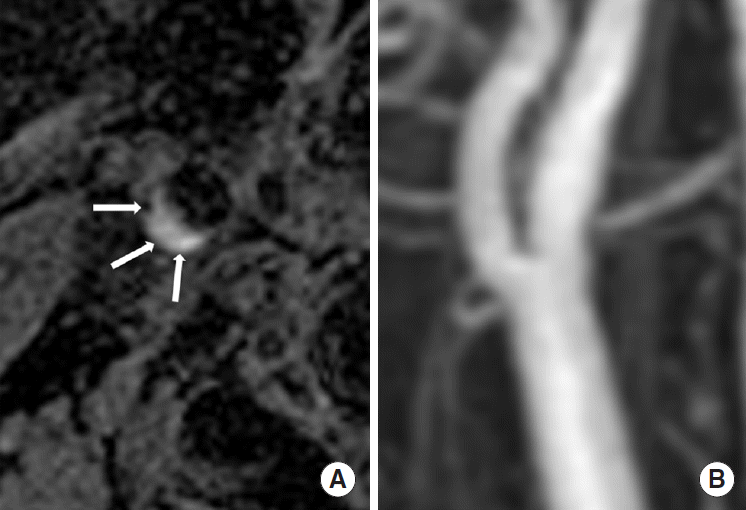Dear Sir:
Previous studies have reported stroke magnetic resonance imaging (MRI) assessments that included a carotid magnetizationprepared rapid acquisition with gradient-echo (MPRAGE) sequence. The findings of these studies showed that a carotid MPRAGE-positive signal was associated with an increased risk of territorial cerebral ischemic events, as detected by brain diffusion-weighted imaging (DWI) [1]. This study evaluated the effectiveness of carotid MPRAGE added to standard brain MRI with contrast-enhanced MR angiography (CE-MRA) as an outpatient screening tool for detecting and evaluating carotid intraplaque hemorrhage (IPH) location.
From November 2013 to November 2015, 2,036 outpatients were enrolled for carotid wall imaging using the MPRAGE sequence and carotid contrast-enhanced MR angiography within the standard brain MRI protocol at 3.0-T (Achieva, Philips Healthcare, Best, The Netherlands). An experienced neuroradiologist excluded images with the following traits: no carotid artery suppression, poor imaging quality, internal carotid artery (ICA) total occlusion, previous stent insertion or endarterectomy, or incomplete coverage of ICA bifurcation. Carotid plaques were defined as having wall thickness greater than 2 mm in at least 2 consecutive slices on MPRAGE imaging. Carotid plaques with a high signal intensity on MPRAGE (i.e., >200% of the adjacent muscle in at least 2 consecutive slices) were defined as IPH. The locations of IPH were divided into common carotid artery, carotid bifurcation, and ICA.
Among the 1,737 subjects underwent carotid wall MR imaging, 291 carotid plaques were detected in 226 subjects (13%) and enrolled in the study. Among these, 146 carotid plaques (50.2%) of 118 subjects (52.2%) demonstrated MR-positive IPH. Patient demographics between the two groups were similar. Among the subjects with carotid plaques, 65 (28.8%) showed bilateral lesions and 28 patients (12.4%) were recorded as showing bilateral MR-positive IPH. The findings of the carotid plaque in patients are shown in Table 1. The degree of carotid stenosis was significantly higher in the MR-positive IPH group (P=0.001). The prevalence of moderate- to high-grade stenosis (>50%) was significantly higher in the IPH-positive group. Among patients with carotid plaques, 101 (34.1%) showed normal angiographic findings on CE-MRA. Among these with normal angiographic findings, 43 (42.6%) carotid plaques with IPH were detected. The locations of IPH in the carotid artery are summarized in Table 2. Among subjects with IPH in the common carotid artery (CCA), 29 patients (90.6%) recorded normal angiographic findings on CEMRA (Figure 1). Normal angiographic findings on CE-MRA were significantly more common in subjects with CCA IPH than in those with ICA IPH.
Prospective studies have found a relationship between the presence of IPH at baseline and ischemic stroke [1,2]. The presence of IPH was associated with a six-fold higher risk for stroke events and the annual event rate in subjects with detectable IPH was 17.71% as compared with 2.43% in patients without IPH [3]. The development of IPH also posed immediate and long-term atherosclerosis-promoting effects on plaque progression and altered the biology and natural history of carotid atherosclerosis [4,5]. Among patients with CCA plaques with IPH, 29 (90.6%) demonstrated normal angiographic findings, which suggest that most CCA plaques with IPH are not identified on CE-MRA. Therefore, CE-MRA might play a limited role in detecting small plaques and IPH in accordance with the North American Symptomatic Carotid Endarterectomy Trial criteria. Although normal angiographic findings were seen in carotid CE-MRA, one-step vessel wall imaging using MPRAGE and luminal imaging using CE-MRA would be useful in early identification of carotid plaque and IPH. In conclusion, the inclusion of carotid wall imaging using MPRAGE sequence and CE-MRA to routine brain MR studies is a useful tool in screening for early detection of carotid plaque and IPH.










